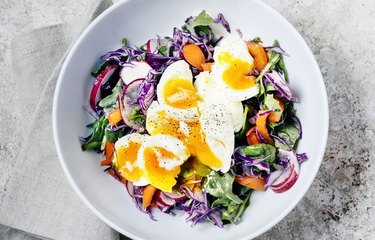
A diverticulitis attack can be a very painful experience. This illness occurs when diverticuli pockets in the lining of your colon become infected. You may experience symptoms of stomach pain, nausea, vomiting and bloody stools.
Until your symptoms improve, your doctor may recommend bowel rest, intravenous fluids and medications. When your doctor allows you to start eating solid foods again, a soft diet is often encouraged initially to allow your body to heal.
Video of the Day
Video of the Day
Breads, Cereals and Grains
Starchy breads, cereals and grains can easily be part of your soft diet after a diverticulitis attack. Choose items that are white or made from refined wheat. Select soft breads without tough crusts. You can eat as snacks or as a meal, bland or hot cereals that are low in fiber. Typically, you can also tolerate white pasta and noodles, and this can add calories to your meal.
Foods to avoid are starches that have three or more grams of fiber per serving, breads or cereals with nuts and seeds and fried or high-fat chips and crackers.
Fruit and Vegetables
Incorporating easy-to-digest fruits and vegetables is also recommended with your soft diet. You can use fruit and vegetable juices without chunks or pulp as a beverage. You can also eat soft fruits such as bananas, melon, applesauce or canned fruits like mandarin oranges, peaches or pears. You are less likely to tolerate fruits that have seeds or membranes, as well as any dried fruit.
You should steam vegetables in your soft diet, and they should be fork-tender. Carrots and mashed potatoes are good choices. Avoid raw, gas-forming vegetables like broccoli, onions, cauliflower and cabbage to prevent stomach discomfort.
Dairy Products
Foods from the dairy group can be a good source of protein and calories while you are on the soft diet. You can also include milk, smooth yogurt, hard cheese, cottage cheese, pudding, ice cream and smoothies at meals. Observe your tolerance to fat, and if you have stomach pain or diarrhea with higher fat foods, try to select a lower fat product.
Meats and Meat Substitutes
The soft diet can also include moist, easy-to-chew meats. Select lean options from beef, chicken, turkey and fish. Eggs are an excellent source of protein and are usually well tolerated. You can eat soy products for a non-meat selection. Meats or protein sources that you should limit while on a soft diet are those with higher fat or those that have a lot of added seasonings, as well as difficult-to-chew foods.
Other Soft Diet Recommendations
Besides grains, fruits, vegetables, dairy and meat, other foods exist that you can eat with your soft diet. You can consume bland soups like chicken noodle or broths, for example. You can also include butter, margarine and cooking oils, as well as mild seasonings. You can also safely consume desserts, without added nuts or coconut.
Is this an emergency? If you are experiencing serious medical symptoms, please see the National Library of Medicine’s list of signs you need emergency medical attention or call 911.